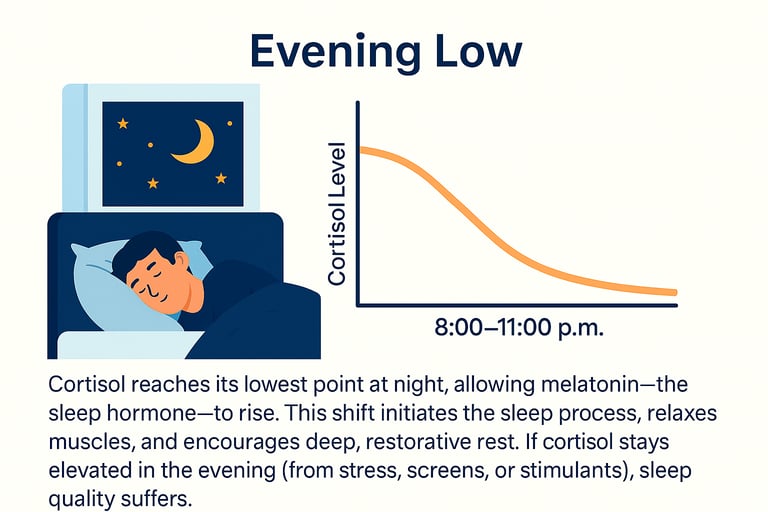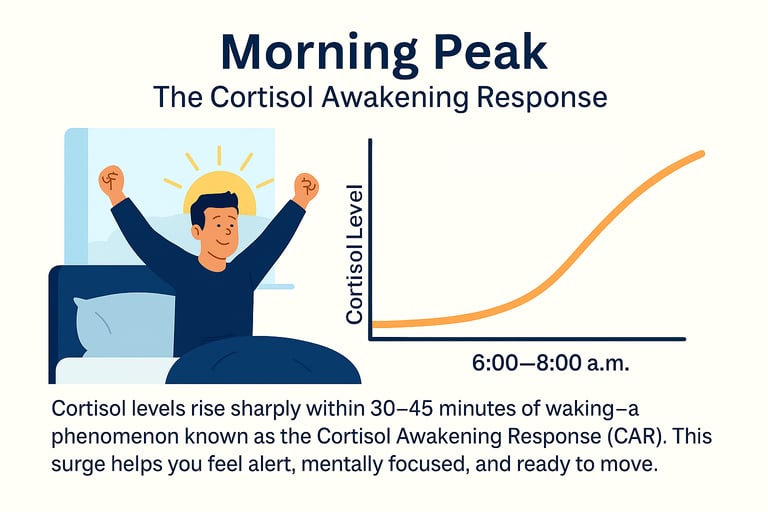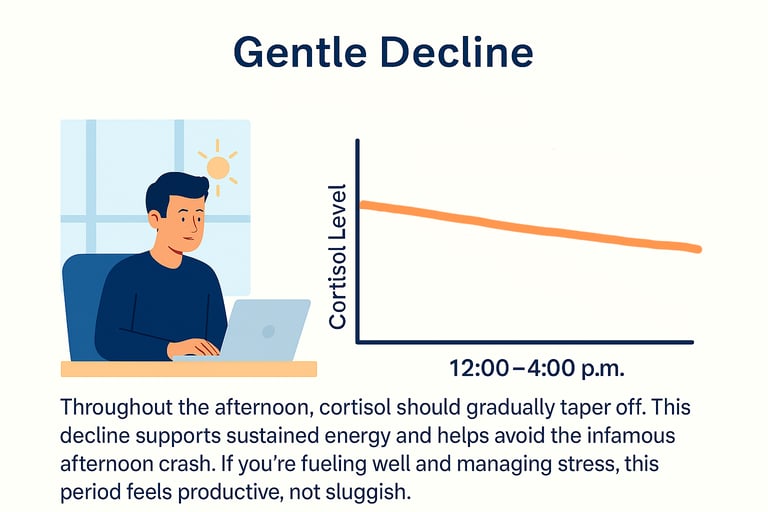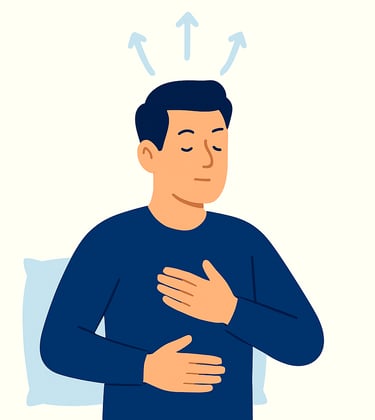

Cortisol Control
Daily Habits That Reduce Chronic Stress Hormones
Understanding Cortisol: Why It Matters More Than You Think
Cortisol isn’t the enemy—but chronically elevated levels can wreak havoc on your mind and body. This powerful hormone follows a natural rhythm aligned with your circadian clock, peaking in the morning and declining at night. But modern life—with its artificial lights, late-night emails, endless coffee, and overstimulation—can flatten that rhythm, leaving you tired but wired. In this article, we dive into how strategic daily habits can reduce cortisol levels and restore your natural hormonal balance. From caffeine timing and breathwork to light exposure and social connection, you’ll discover practical routines to help your body work with cortisol, not against it.
What Is Cortisol and Why Should You Care?
Cortisol is a glucocorticoid hormone produced by your adrenal glands, which sit on top of your kidneys. It plays a central role in your body’s stress response, but its influence goes far beyond reacting to emergencies. Cortisol is involved in a wide range of critical functions, including:
Regulating metabolism
Managing blood pressure
Controlling blood sugar levels
Reducing inflammation
Influencing memory formation and emotional tone
Because of its wide reach, cortisol is often referred to as the “master hormone” when it comes to stress and energy regulation.
Cortisol: Friend or Foe?
In short bursts, cortisol is incredibly helpful. It gives you a temporary performance edge—sharpening your focus, increasing energy, and preparing your body to take action. This is known as the fight-or-flight response, and it’s vital for survival.
However, modern life doesn’t always give us a break. When your body is exposed to chronic stress—be it from lack of sleep, poor nutrition, emotional strain, high workloads, or even excessive exercise—your adrenal glands keep pumping out cortisol long after the immediate “threat” is gone.
This state of prolonged elevation leads to a number of health issues, including:
Fat storage, particularly around the midsection (visceral fat), where cortisol receptors are most concentrated
Disrupted sleep, especially difficulty falling or staying asleep
Mood swings, anxiety, or irritability due to interference with neurotransmitters like serotonin
Weakened immune response, making you more prone to illness
Hormonal imbalances, including reduced thyroid function and sex hormone suppression (like low testosterone or estrogen disruption)
Over time, persistently high cortisol can also dull your body’s natural cortisol rhythm, leading to burnout or even adrenal fatigue-like symptoms—where you feel exhausted, mentally foggy, and unable to recover from daily demands.
Realigning, Not Overhauling
The good news? You don’t need to quit your job, move to the mountains, or live in a sensory deprivation tank to reduce cortisol levels. What you need is better rhythm—a daily structure that works with your biology instead of fighting it.
By aligning your habits with your body’s natural circadian rhythm—when to wake, eat, move, relax, and sleep—you can guide cortisol back into its healthy pattern. This isn’t about rigid routines or perfection. It’s about making small, intentional shifts that build resilience and restore balance over time.
Cortisol isn’t your enemy—it’s your ally when kept in check. The goal is to train your body to release cortisol at the right times, so you feel energized in the morning, productive during the day, and truly relaxed at night.
The Cortisol Curve: Your Hormonal Circadian Rhythm
Cortisol operates on a 24-hour circadian rhythm—your body’s internal clock that governs sleep, energy, hormone release, and alertness. This rhythm is closely tied to light exposure, wake-sleep timing, and daily behavior patterns. Cortisol isn’t inherently bad—it’s essential for waking up, thinking clearly, and handling challenges. But like any system, it depends on balance.
A Healthy Cortisol Rhythm Looks Like This:






What Disrupts the Curve?
Several modern habits can flatten or invert this natural rhythm:
Caffeine first thing in the morning can overstimulate and shift cortisol peaks unnaturally.
Late-night screen use (especially blue light) suppresses melatonin and keeps cortisol high.
Chronic stress or emotional reactivity triggers an overproduction of cortisol—even when there’s no real threat.
Sleep deprivation or irregular bedtimes confuse the brain about when to release which hormones.
Why It Matters
When cortisol doesn’t follow its natural ebb and flow, the consequences compound:
You may wake up tired despite a full night’s sleep.
You’ll feel wired at night when you should be winding down.
You might rely more on stimulants and experience more crashes.
Long-term flattening of the curve contributes to weight gain, immune dysfunction, inflammation, and even burnout.
The Goal Isn’t Zero Cortisol—It’s Rhythm
Cortisol is essential. The problem isn’t its presence, but the loss of pattern. Your body thrives when cortisol:
Spikes in the morning to energize you,
Sustains in the afternoon to help you function, and
Drops in the evening to allow rest and recovery.
By aligning your behaviors—light exposure, caffeine, food, stress management, and sleep—with this rhythm, you optimize your hormonal health and build resilience against chronic stress.
Habit 1: Sync with Natural Light
Why it works:
Sunlight, especially in the morning, signals the brain to regulate cortisol and melatonin properly. Research shows morning light exposure enhances mood and aligns the cortisol awakening response (CAR), a natural surge within 30 minutes of waking.
What to do:
Get 5–15 minutes of direct sunlight within 30 minutes of waking
If indoors, sit near a window or use a full-spectrum lightbox
Dim lights 1–2 hours before bed to reduce evening cortisol
Bonus: Morning light also helps regulate sleep-wake cycles and improves metabolic fun


Habit 2: Use Caffeine Wisely
Why it works:
Caffeine increases cortisol, especially when consumed first thing in the morning or during stressful periods. Misusing it can create a “second cortisol peak” that leads to crashes or insomnia.
What to do:
Delay caffeine for 60–90 minutes after waking to align with the natural cortisol spike
Avoid caffeine after 2 p.m. to prevent sleep disruption
Opt for decaf or adaptogens (like rhodiola or ashwagandha) in the afternoon
Science spotlight: A 2005 study in Psychosomatic Medicine confirmed that caffeine boosts cortisol more in people already under stress.


Habit 3: Breathe to Balance
Why it works:
Slow, diaphragmatic breathing reduces activation of the sympathetic nervous system (fight or flight), signaling the body that it’s safe—this reduces cortisol output almost immediately.
Try this Box Breathing protocol:
Inhale for 4 seconds
Hold for 4 seconds
Exhale for 4 seconds
Hold for 4 seconds
Repeat for 2–5 minutes before meetings, meals, or bedtime.
Other breath options:
4-7-8 Breathing (great for sleep)
Resonant Breathing (6 breaths per minute)


Habit 4: Prioritize Human Connection
Why it works:
Social connection triggers oxytocin, a hormone that naturally lowers cortisol. Chronic isolation, on the other hand, can elevate stress hormones and increase inflammation.
What to do:
Schedule regular face-to-face interactions
Practice “co-regulation”: talking with someone calm can help regulate your own nervous system
Physical touch (hugging, holding hands) boosts oxytocin and lowers cortisol
Interesting fact: Laughter and shared joy have been shown to reduce cortisol in as little as 15 minutes.


Habit 5: Structure Your Day: Morning and Evening Rituals
Morning Rituals to Encourage a Healthy Cortisol Peak:
Wake at the same time daily, ideally around sunrise
Step outside for natural light exposure
Hydrate before reaching for caffeine
Move your body: light cardio, walking, or mobility work triggers a healthy cortisol pulse
Journal or visualize to prime your mindset for the day
Evening Rituals to Lower Cortisol:
Dim lights and limit screen time 1–2 hours before bed
Avoid intense exercise late at night (it spikes cortisol)
Stretch or foam roll to engage the parasympathetic system
Listen to music, read, or practice breathwork
Keep bedtime consistent, even on weekends
Tips for Long-Term Cortisol Control
Nutrition: Stabilize blood sugar with protein- and fiber-rich meals
Adaptogens: Herbs like ashwagandha, holy basil, and rhodiola have cortisol-lowering potential
Magnesium: Supports nervous system regulation, especially glycinate or threonate forms
Alcohol: While it feels relaxing short-term, it actually increases cortisol and disrupts sleep
Sleep: Non-negotiable. Aim for 7–9 hours of deep, consistent rest
Final Thoughts: Don’t Fear Cortisol—Work With It
Cortisol is your friend when in balance. It helps you rise in the morning, respond to challenges, and power through workouts. But if you live in constant fight-or-flight mode, your biology will start working against you. Instead of chasing extreme fixes, focus on simple, daily rhythms that gently guide your body back into alignment.
By understanding your circadian pattern and layering small, intentional habits throughout the day, you can reduce cortisol levels, feel more energized, and build real, lasting resilience.
Reference List
Cortisol Awakening Response and Stress Regulation
Study: The cortisol awakening response: more than a measure of HPA axis function
Source: Neuroscience & Biobehavioral Reviews (Clow et al., 2010)
Link: https://pubmed.ncbi.nlm.nih.gov/20026350/
Summary: This review highlights the cortisol awakening response (CAR) as a key marker of HPA axis activity, influenced by stress, sleep quality, and circadian rhythm regulation.Caffeine's Impact on Cortisol Secretion
Study: Caffeine stimulation of cortisol secretion across the waking hours in relation to caffeine intake levels
Source: Psychosomatic Medicine (Lovallo et al., 2005)
Link: https://pubmed.ncbi.nlm.nih.gov/16204431/
Summary: The study demonstrated that caffeine consumption elevates cortisol levels throughout the day, with habitual users showing a blunted cortisol response, indicating partial tolerance.Light Exposure and Circadian Rhythm
Study: Entrainment of the human circadian clock to the natural light-dark cycle
Source: Current Biology (Wright et al., 2013)
Link: https://pubmed.ncbi.nlm.nih.gov/23910656/
Summary: This study found that exposure to natural light-dark cycles realigns the human circadian clock, leading to improved sleep timing and hormonal balance, including healthier cortisol patterns.Breath-Control Techniques and Stress Reduction
Study: How breath-control can change your life: a systematic review on psycho-physiological correlates of slow breathing
Source: Frontiers in Human Neuroscience (Zaccaro et al., 2018)
Link: https://www.frontiersin.org/articles/10.3389/fnhum.2018.00353/full
Summary: This systematic review found that slow, controlled breathing enhances autonomic function, increases heart rate variability, and reduces stress and anxiety levels, thereby promoting overall well-being.SCIRP+2PhilPapers+2SCIRP+2Social Support, Oxytocin, and Cortisol Reduction
Study: Social support and oxytocin interact to suppress cortisol and subjective responses to psychosocial stress
Source: Biological Psychiatry (Heinrichs et al., 2003)
Link: https://pubmed.ncbi.nlm.nih.gov/14675803/
Summary: This study demonstrated that the combination of social support and oxytocin administration significantly reduces cortisol levels and perceived stress, highlighting the importance of social connections in stress regulation.
